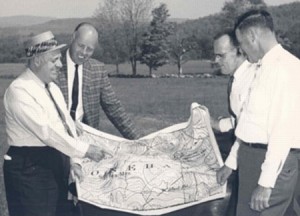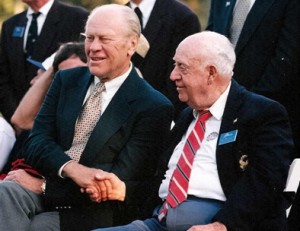 Robert Trent Jones, Sr. was born in 1906 in Ince, England, a town on the Trent River – from which his middle name derives, He went with his parents to the United States in 1911, to live in East Rochester, New York. Over a period of seven decades, he has designed (or re-designed) some 500 golf courses in 35 countries; it is not only the quantity of his work that impresses, however; it is also the number of enduring golf courses he has created, and the fact that he never tires of turning them out.
Robert Trent Jones, Sr. was born in 1906 in Ince, England, a town on the Trent River – from which his middle name derives, He went with his parents to the United States in 1911, to live in East Rochester, New York. Over a period of seven decades, he has designed (or re-designed) some 500 golf courses in 35 countries; it is not only the quantity of his work that impresses, however; it is also the number of enduring golf courses he has created, and the fact that he never tires of turning them out.
A fine golfer in his own right, he held a few jobs as club pro and teacher, even competing in several professional events. He became the first person to study expressly for a career as a golf course designer. He fashioned his own program of study at Cornell University, drawing upon courses in landscape architecture, agronomy, horticulture, hydraulics, surveying, public speaking and economics.
Robert Trent Jones made his reputation after World War II with a handful of high-profile projects, he created the putting green at the White House for Dwight Eisenhower and a hole with three different tees at Camp David, the President’s weekend retreat. He also helped found the American Society of Golf Course Architects in 1947. He worked with Bobby Jones on Peachtree (1948) in Atlanta, a course that launched the broad-shouldered, heavily sculpted power golf look that defined the postwar years. Trent Jones also worked on Augusta National, transforming the 11th and 16th holes from indifferent to bold and memorable. And he became a national celebrity in 1951, owing to his complete redesign of Oakland Hills-South Course for the U.S. Open that year. While retaining Ross’ routing and his green sites, he filled in all of Ross’ fairway bunkers at Oakland Hills, moved them back to the 230-270 yard range off the tee, and created “a Monster” out of what had been a much more modest, if always sound layout.
Trent Jones’ reputation was made. He became “The Open Doctor” – the man to whom clubs turned in prepping their courses for a U.S. Open. In quick succession, he worked such major venues as Baltusrol-Lower Course, Olympic-Lake Course, Southern Hills, Oak Hill, and Congressional. Beyond his considerable abilities as a visionary of golf land, he acquired a well-deserved reputation as a brilliant salesman and promoter. He had an uncanny ability to meet the right people and to cultivate relationships with the giants of industry, and in some cases, the kings of countries.
Related posts
Golf Architects/Designers: Geoffrey Cornish
on Tuesday 17, JuneGeoffrey S. Cornish (August 6, 1914 – February 10, 2012) was a golf course...
Golf Architects/Designers: Dick Wilson
on Monday 12, MarchLouis Sibbett (“Dick”) Wilson was among the most respected of post-World War II period...
Golf Architects/Designers: John Fought
on Tuesday 29, JulyJohn Fought III (born January 28, 1954) is an American golf course architect and...


